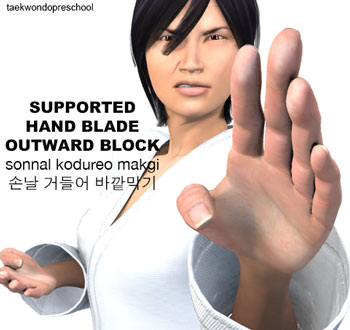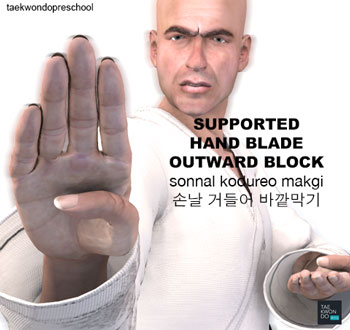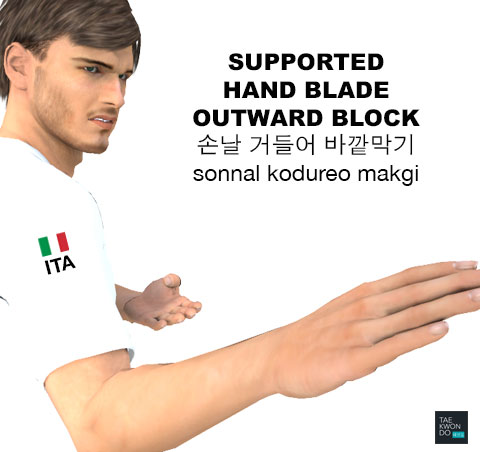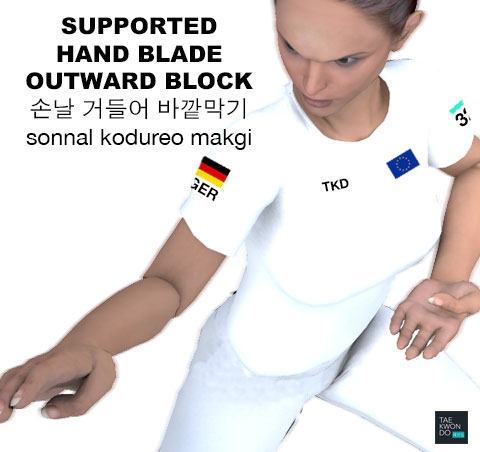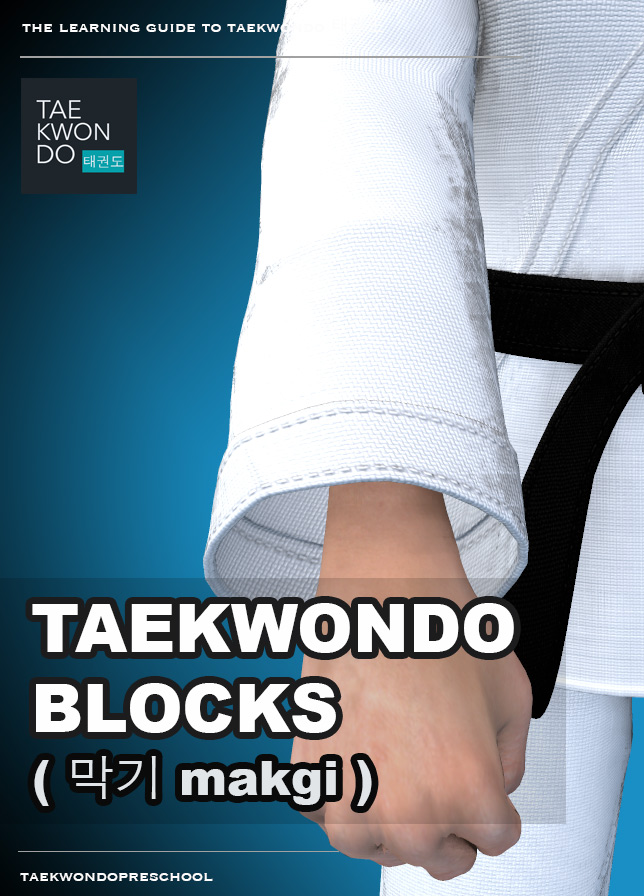Taekwondo 태권도Taekwondo Preschool
When you reach senior belt you are expected to guide the junior belts when they are beginning Taekwondo such as showing by example. To advance from one rank to the next, students typically complete promotion tests in which they demonstrate their proficiency in the various aspects of the art before a panel of judges or their teacher. View Taekwondo belt levels »
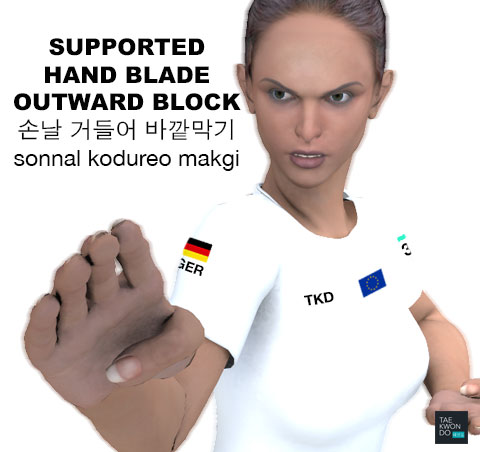
Supported Hand Blade Outward Block
손날 거들어 바깥막기 sonnal-kodureo-makgi
Difficulty Level: Intermediate Technique: Blocks ( 막기 makgi )
In the Supported Hand Blade Outward Block ( 손날 거들어 바깥막기 sonnal-kodureo-makgi ), the lead hand ( 손 son ) is kept in a knife hand ( 손날 sonnal ) posture to block ( 막기 makgi ) attacks to the torso while the rear hand (also in knife hand posture) could be used as a counter strike.
The blocking hand starts from shoulder level with the palm ( 손바닥 sonbadak ) up while you stretch the other hand far from the waist with the palm ( 손바닥 sonbadak ) facing downward at shoulder height level. Both hands come across the body, intersecting at the forearms and providing a firm defense blocking the attack. Also with both hands held out open in the knife hand ( 손날 sonnal ) posture, a kick ( 차기 chagi ) aimed at the solar plexus can be successfully blocked.
The knife hand ( 손날 sonnal ) is used often as both an offensive and defensive technique which can be executed as a high, low, middle, side, inward, outward, rising or circular. Use of this technique as a block ( 막기 makgi ) is featured prominently in many of the World Taekwondo (WT) Poomse. Taekwondo poomse are the learning ground for real combat. As such, every technique must display the requisite speed, power and firmness to be realistically used as an attack or defense move.
Other Supported Blocks ( 거들어 kodureo-makgi )
- Supported Trunk Block ( 거들어막기 momtong-kodureo-makgi )
- Supported Hand Blade Block ( 손날 거들어 바깥막기 sonnal-kodureo-makgi )
- Supported Downward Hand Blade Block ( 손날 거들어 내려막기 sonnal-kodureo-naeryeo-makgi )
- Outside Wrist Supported Trunk Block ( 바깥팔목 거들어 바깥막기 bakkatpalmok-kodureo-bakkat-makgi )
- Supported Downward Block ( 거들어 내려막기 kodureo-naeryeo-makgi )
- Ridgehand Supporting Downward Block ( 손날등 거들어 내려막기 sonnal-deung-kodureo-naeryeo-makgi )
- Inner Wrist Supporting Side Block ( 안팔목 거들어 옆막기 anpalmok-kodureo-yeop-makgi )
- Inner Wrist Supporting Outward Block ( 안팔목 거들어 바깥막기 anpalmok-kodureo-bakkat-makgi )
- Palm Assisting Outer Block ( 손바닥 거들어 바깥막기 sonbadak-kodureo-bakkat-makgi )
Training Methods
How well one improves with training depends on several factors, such as the frequency it is engaged in, and the type of feedback that is available for improvement. If a student does not train often enough, reinforcement fades, and he or she is likely to forget what was learned.
When learning the block ( 막기 makgi ), it is helpful to use mirrors to observe your technique and fix your mistakes immediately. Initially, a student may need focused feedback from a certified Master Instructor ( 사범님 sabeomnim ); however, as they progress, they must develop the ability to self-assess the block ( 막기 makgi ).
The technique is also learned by blocking in the air as though there is an opponent striking but focusing on the form, speed, and technique; then moving on to partner training (self-defence scenarios, sparring practices, one-step sparring, etc) reinforcing the block ( 막기 makgi ) on a realistic moving attack.
In preparation for full contact sparring, students may be required to wait a few months, for safety reasons, because they must first build the skills they would ideally employ in their sparring practice. Some schools restrict the amount of force that may be used to hit an opponent, by allowing 'light contact' during sparring. Light contact allows a student to hit an opponent getting the feel of impacting the opponent but with controlled force and not full power. Light contact sparring is a good method to practice the block ( 막기 makgi ).
Difficulty of Technique
Taekwondo students of geup ranking learn the most basic techniques first, and then move on to more advanced and difficult techniques as they approach 1st Dan Black Belt. The more difficult the technique, the more practice may be needed for the purpose of improving or mastering it, as in the phrase 'practice makes perfect'. Every technique must display the requisite speed, balance, power and firmness to be realistically used as an attack or defense move.
* Please see a certified Master Instructor ( 사범님 sabeomnim ) for training. Proper guidance and instructions are needed to ensure safe training.
Promotion Tests
Students often undergo periodic testing and grading by their own Master Instructor ( 사범님 sabeomnim ) in order to advance to a higher level of recognized achievement such as a different belt color. They need to demonstrate their proficiency in the various aspects of the art such as the execution of patterns ( 품새 poomse ), which combine various techniques in specific sequences.
Supported Hand Blade Outward Block ( 손날 거들어 바깥막기 sonnal-kodureo-makgi ) is a requirement for the below belt levels (Techniques vary between schools). Promotion from one belt level to the next can proceed rapidly in some schools, since schools often allow geup promotions every two, three, or four months. Students of geup rank learn the most basic techniques first, and then move on to more advanced techniques as they approach first dan black belt. View Promotion Tests »
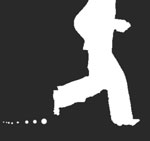
Training Safety Precautions
Usually before the taekwondo class starts, the master ( 사범님 sabeomnim ) instructs the students to jog around the dojang to warmup. Depending on the size of the dojang, several laps are done. Risk of injury can be reduced by completing an effective warm-up consisting of a heart raiser to get your pulse up, followed by sport specific dynamic stretches (stretches whilst moving).
* Please see a certified Master Instructor ( 사범님 sabeomnim ) for training. Proper guidance and instructions are needed to ensure safe training.

Training Highlights Summary
The Supported Hand Blade Outward Block ( 손날 거들어 바깥막기 sonnal-kodureo-makgi ) contains many key point highlights. There are some that are simple and straightforward but then some are complex and detailed that require repeated training to learn and master.
- the lead hand is kept in a knife hand ( 손날 sonnal ) posture to block attacks to the torso
- the rear hand (also in knife hand posture) could be used as a counter strike
- both hands come across the body, intersecting at the forearms and providing a firm defense blocking the attack
- the blocking arm's elbow and the supporting hand should not be touching each other
- wrist ( 팔목 palmok ) must also be kept straight in proper alignment during the posture
Precision of Blocking ( 막기 makgi ) Technique
Depending on the strike, one may block ( 막기 makgi ) an attack most commonly by placing a limb across the line of the attack. Some techniques can block and deflect an attack with more precision which allows an effective counterstrike. The below is an approximate measurement of how precise the block requires from the practitioner to be effective.
Experienced practitioners learn through repetition and muscle memory when (not just how) to launch particular blocks ( 막기 makgi ), based on the circumstances they are facing.
* Please see a certified Master Instructor ( 사범님 sabeomnim ) for training. Proper guidance and instructions are needed to ensure safe training.
There are five tenets defined in the International Taekwondo Federation (ITF) and several more in World Taekwondo (WT).
Indomitable Spirit ( 백절불굴 baekjul-boolgool ): "To have indomitable spirit means to have the courage to stand up for what you believe in, no matter what odds you are up against, and to always give 100% effort in whatever you do." View Taekwondo Tenets »
RESOURCES
This article uses material from the Wikipedia article "List of Taekwondo Techniques", which is released under the Creative Commons Attribution-Share-Alike License 3.0.






